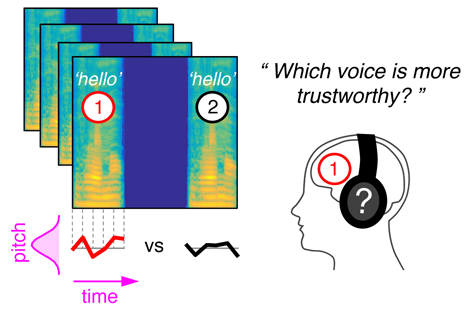Global S&T Development Trend Analysis Platform of Resources and Environment
| How to make a good impression when saying hello | |
| admin | |
| 2018-03-26 | |
| 发布年 | 2018 |
| 语种 | 英语 |
| 国家 | 法国 |
| 领域 | 地球科学 |
| 正文(英文) | You can hear the perfect hello. And now you can see it too. Researchers from the CNRS, the ENS, and Aix-Marseille University1 have established an experimental method that unveils the filterthat is, mental representationwe use to judge people when hearing them say a word as simple as hello. What is the ideal intonation for coming across as determined or trustworthy? This method is already used by these researchers for clinical purposes, with stroke survivors, and it opens many new doors for the study of language perception. The team's findings are published in PNAS (March 26, 2018).When people you meet for the first time say hello, do they strike you as friendly or hostile? The linguistic and social judgments we make when hearing speech are based on intonation. Just as we have a mental image of what an apple looks likeround, green or red, with a stem, etc.we form mental representations of others' personalities according to the acoustic qualities of their voices. For the first time ever, researchers have managed to visually model these mental representations and compare those of different individuals. To do this, they developed a computer program for voice manipulation called CLEESE. This software can take the recording of a single word and randomly generate thousands of other variant pronunciations that are all realistic but each unique in their melodysort of like putting makeup on the original recording. Then, by analyzing participants' responses when hearing these different pronunciations, the researchers were able to experimentally determine what intonation makes a hello seem sincere. To sound determined, a French speaker must pronounce bonjour (French for hello") with a descending pitch, putting emphasis on the second syllable This method of investigation could be used to answer many other questions in the field of language perception. For example, how do these findings play out at sentence level? And do mental representations vary with the language being spoken? It may also serve to understand how emotions are represented by autistic individuals. To help others answer these questions, the research team has made CLEESE freely available here. The team members themselves have already found a clinical application for the program: to study how words are interpreted by survivors of a stroke, an event which can alter how they perceive vocal intonation. Whether for the purposes of medical monitoring or diagnosis, the researchers would like to use their method to detect anomalies in language perception and possibly make it a tool for patient rehabilitation.
 © CNRS/ENS/AMU Method used to model mental representations of vocal intonation. Participants consider the intonation of many computer-generated recordings of bonjour (hello) and decide which, for example, inspire trust. Analysis of thousands of responses makes it possible to visually model a person's auditory mental representations. Notes:1The scientists hail from the Science and technology of music and sound research lab (CNRS / IRCAM / French Ministry of Culture / Sorbonne University), the Laboratoire des systèmes perceptifs (CNRS / ENS Paris), and the Institut de neurosciences de la Timone (CNRS / Aix-Marseille University). Bibliography:Cracking the social code of speech prosody using reverse correlation. Emmanuel Ponsot, Juan José Burred, Pascal Belin & Jean-Julien Aucouturier, PNAS, 26 March 2018. DOI : 10.1073/pnas.1716090115 Contacts: CNRS researcher | Jean-Julien Aucouturier | aucouturier@gmail.com |
| URL | 查看原文 |
| 来源平台 | Centre national de la recherche scientifique |
| 文献类型 | 新闻 |
| 条目标识符 | http://119.78.100.173/C666/handle/2XK7JSWQ/107015 |
| 专题 | 地球科学 |
| 推荐引用方式 GB/T 7714 | admin. How to make a good impression when saying hello. 2018. |
| 条目包含的文件 | 条目无相关文件。 | |||||
| 个性服务 |
| 推荐该条目 |
| 保存到收藏夹 |
| 查看访问统计 |
| 导出为Endnote文件 |
| 谷歌学术 |
| 谷歌学术中相似的文章 |
| [admin]的文章 |
| 百度学术 |
| 百度学术中相似的文章 |
| [admin]的文章 |
| 必应学术 |
| 必应学术中相似的文章 |
| [admin]的文章 |
| 相关权益政策 |
| 暂无数据 |
| 收藏/分享 |
除非特别说明,本系统中所有内容都受版权保护,并保留所有权利。
修改评论